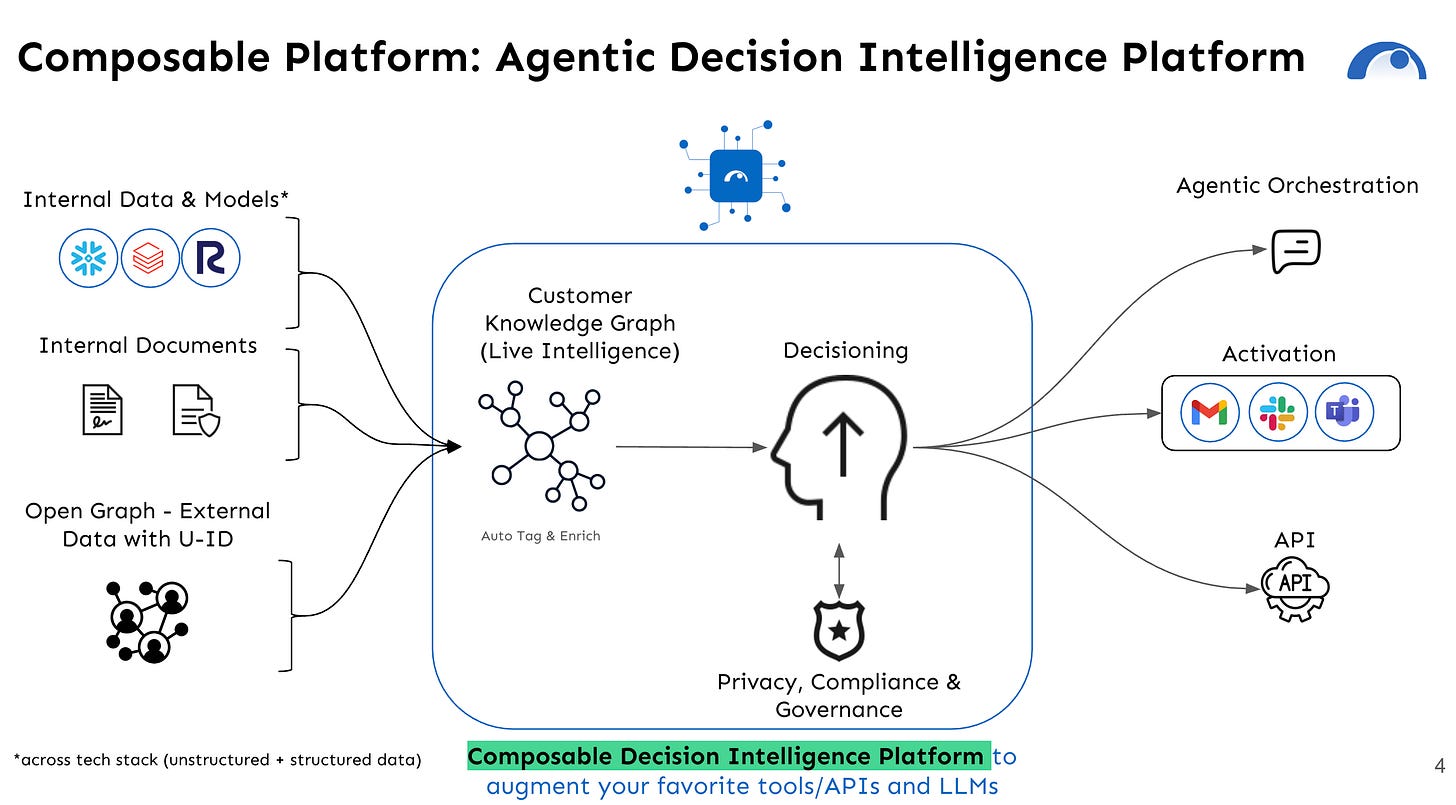From Analytics to Agentic AI: The New Frontier of Customer Decisioning
How customer intelligence evolved from dashboards, propensity scores to real-time, autonomous systems—and what leaders need to do next
We’ve all heard the AI lingo—predictive analytics, machine learning, reinforcement learning. But here’s the honest question: what’s actually changed?
Turns out, a lot more than just better models & Gen AI news fatigue.
We’ve gone from running churn scores to building systems that act—in real time, autonomously. What used to be “insights for humans” is turning into “decisions by machines.”
If you’re building CX, digital products, or growth systems, this is your field guide for how customer decisioning has evolved—and what’s coming next.
Looking Back: CDP, Customer 360 & the Framework We All Started With
Someone recently called me a Customer 360 veteran—and while I still feel like I’m just trying to level up in this holy grail topic, it’s true. I’ve been doing this a while.
Back when “CDP” (customer data platform) wasn’t yet mainstream, I was working with teams defining the early frameworks for modern CX. The structure was simple but powerful:
Data → Decision → Delivery
Data: Stitch everything together across systems & external data marketplace
Decision: Score, segment, model—usually by analysts, data scientist in notebooks
Delivery: Push it out as campaigns, sequences—email, ad, push, SMS, content
That loop served us for years.
But let’s be real: much of that logic was rigid. Most decisioning was hardcoded. Delivery was often spray-and-pray. And the loop wasn’t real-time—or even close to it.
Now, the whole model is shifting.
What’s Changing: From Predictive to Agentic
Customer decisioning isn’t just predictive anymore—it’s becoming agentic: autonomous, adaptive, and goal-seeking. And that changes everything—how we segment, prioritize, personalize, orchestrate, and optimize.
The Old World: Predictive Analytics as Decision Support
This was the original setup:
Run a churn model
Get a list of “likely to leave” customers
Hand it to retention teams and hope they act
It was valuable, but static:
Batch-based updates
Human execution
Insights stuck in dashboards
Smarter than guesswork, but not built for speed—or learning.
The Middle Ground: Predictive Intelligence and Feedback Loops
Then we started asking: what if the model could act, and then learn from it?
That brought us into predictive intelligence:
Churn scores trigger real offers
Recommendations update with every click
Prices shift daily with behavior patterns
The loop tightened. But logic stayed hardcoded. These systems didn’t discover better strategies—they just automated what we already knew.
And for most companies, this is still where they are. And that’s okay—this layer works, and it’s understandable. Don’t skip it.
Decision Intelligence: Still Agentic, But With Humans in the Loop
Then came Decision Intelligence: a system where machine learning, automation, and strategy all coexist.
It’s already agentic, in a sense. These systems can act, learn, and improve—but humans still steer.
The AI suggests
People monitor, adjust, and set boundaries
Feedback loops guide improvement
It’s collaborative, not hands-off. And it’s catching on. Gartner says one-third of large enterprises will adopt this model by 2026.
A Real-World Example: Human-AI Collaboration in Retail
Take a fashion subscription brand using a hybrid approach.
AI suggests clothing based on preferences and purchase history
Stylists refine the picks using judgment and context
The system learns from both feedback and behavior
They reported higher satisfaction, lower returns, and scalable personalization. The key wasn’t replacing humans—it was scaling their superpowers.
Credit: iCustomer
The Big Leap: Agentic AI and Autonomous Decisioning
Here’s where it shifts again.
Agentic AI doesn’t just support decisions—it makes them. Then learns. Then improves.
"I see the state. I act. I observe what happens. I adjust."
This isn’t automation. This is autonomous, goal-driven behavior.
Key traits:
Always-on: It never sleeps
Exploratory: It tests and adapts
Goal-seeking: It optimizes for outcomes like LTV or retention
And it operates at the level of individual events and users. No two decisions are the same.
What Makes It Tick: Reinforcement Learning
At the core of agentic systems is reinforcement learning (RL). It’s not trained on static labels—it learns by doing.
Takes an action in a given state
Gets a reward or penalty
Adjusts its strategy over time
These systems track context like:
Customer history
In-session behavior
Business goals and constraints
External market signals
As all of that shifts, the system updates its tactics. Constantly.
Where It’s Already Working
In finance:
Credit limits adjust in real time
Portfolios rebalance as markets move
In e-commerce:
Personalization changes with every session
Offers adapt mid-browse
In retail:
Inventory gets moved between locations dynamically
Shelf pricing updates based on foot traffic and demand
These aren’t just recommendations. They’re decisions—executed and refined at scale.
Case Study: Agentic AI in Global Trading
One global investment bank deployed an RL-driven trading system. It now executes complex trades in milliseconds.
It:
Reads market signals
Adjusts strategies on the fly
Follows strict risk controls
They saw:
40% better execution on some orders
Lower costs from reduced market impact
More bandwidth for traders to focus on higher-level strategy
Even in highly regulated industries, agentic systems are proving they can deliver—safely.
Multi-Agent Architectures: Smarter Together
Many agentic systems now run as networks of AI agents—each specialized, all collaborating.
One agent handles promo targeting
Another manages inventory
Another tunes content delivery
Together, they act like a distributed decision-making engine. Each agent learns locally, but they work globally.
Rethinking Customer Intelligence
Customer data isn’t rows and fields anymore.
It’s:
Clicks, scrolls, taps
Reviews, voice, and chat
In-app behavior and channel signals
And it’s all happening in real time.
Agentic systems can:
Ingest this data continuously
Learn on the fly
Extract meaning from unstructured formats
That’s how we move from “people who bought this also bought that” to “this user responds to urgency, dislikes popups, and values peer reviews.”
The Spectrum of Modern Decisioning
Here’s how the journey looks:
Predictive Analytics → What might happen?
Predictive Intelligence → What should we do?
Decision Intelligence → What should we do now—and what did we learn?
Agentic AI → What action do I take now—and how do I learn faster?
Agentic systems don’t replace humans. They scale smart decisions in real time—aligned to goals, adapting constantly.
Things to Think About Before You Dive In
This isn’t plug-and-play. A few real challenges:
Data infrastructure: You need streaming, unified, semantics enrichment, high-quality inputs
Explainability: Reinforcement learning isn’t always easy to unpack
Deployment complexity: These aren’t simple scripts—they’re systems
Ethical design: Reward functions shape behavior. Design them wisely
None of these are blockers—but they’re real challenges for a lot of DIY (do-it-yourself) inclined enterprise teams, so rethink about build vs buy vs partner.
What to Do Right Now
If you're serious about intelligent customer decisioning:
Rebuild your data foundation in a composable way. Legacy pipelines won’t cut it
Start small. Pick a narrow use case—then scale
Set your guardrails early. Ethics and risk management matter
Align the right incentives. The system learns what you reward
Keep people in the loop. Visibility, override control, and accountability are key
Build hybrid teams. This work lives at the intersection of data, product/program management & business operations i.e Marketing, CX, Revenue Ops
Final Thought
We’ve moved way past using AI to forecast.
It’s now a decision engine—one that’s capable of learning, adapting, and optimizing in ways we could never hard-code.
Yes, it’s a leap. But the companies who lean into this shift—with discipline, strategy, and good “live” data—will define the next decade of customer experience.
The future of decisioning is agentic. And it’s already here.
Just remember: enjoy the ride—but keep your hands near the wheel.




There are clear indicators that agentic approaches are evolving in the ways that you articulate. For organizations that can make the investment in advanced capabilities that form a competitive advantage (such as the trading firm example you provide) a number of foundational elements, built over years, have to be in place. For many orgs that I work with, just getting the basics in place is an enormous challenge. They don’t have harmonized data across their numerous customer facing systems, they are unable to repurpose componentized content for dynamic messaging, they don’t even have well structured product data enriched with the attributes that enable personalization for different customer needs (a procurement manager versus a design engineer in B2B for example). While AI can help with remediation, a reference architecture is needed (not trivial). I had one customer at a large enterprise say to me “this will never happen in my natural lifetime at [ABC company]”. They were making significant investments in these areas but the scale and scope were enormous (over a million pages of content, extremely complex solutions).
I once gave a presentation at a conference on orchestration of digital assets to enable personalization. Lots of slides and complex workflows - an in depth exploration of the issues and challenges etc) and someone raised their hand and said “but I just want to find my stuff…”.
Your Mar 23rd piece articulated these data challenges well https://open.substack.com/pub/abhiyadav/p/retails-ai-reckoning-why-your-data
Many orgs believe that they are missing the boat. In most cases they are not even near the ocean.